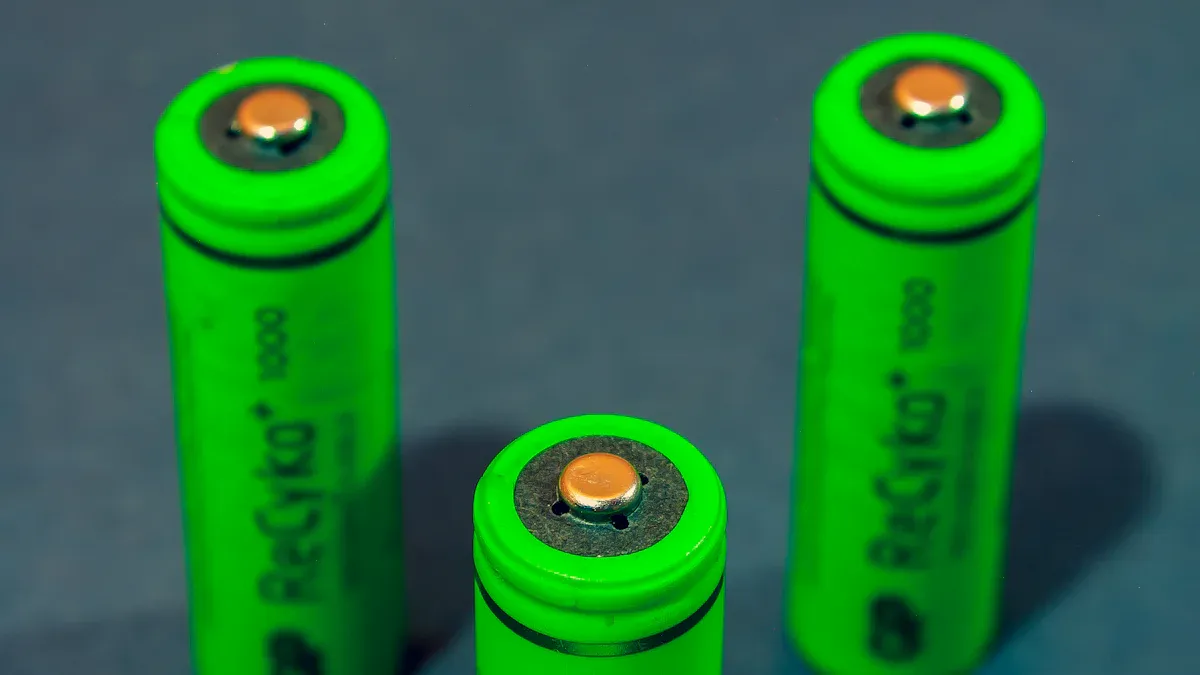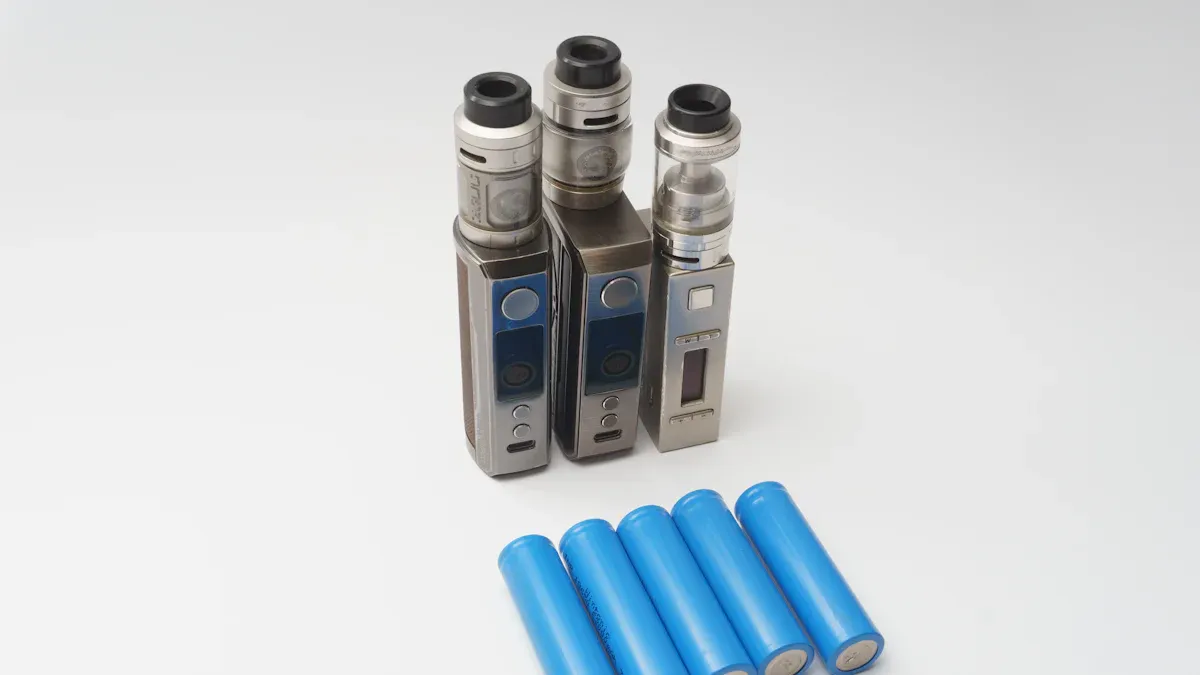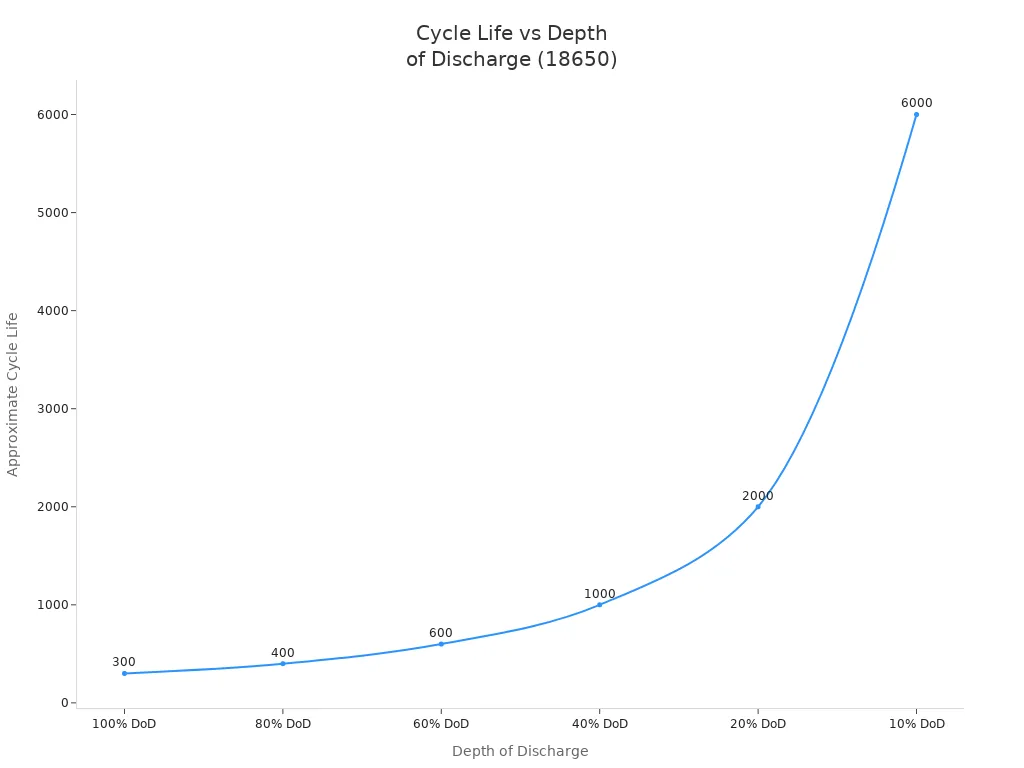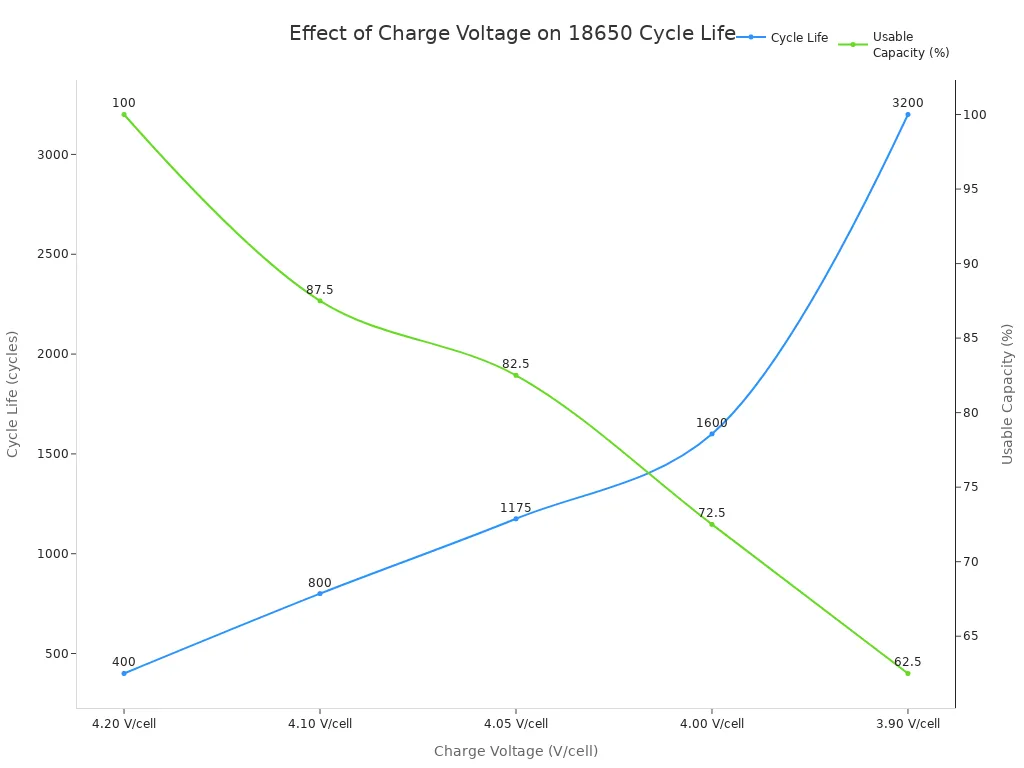
Many things can shorten 18650 battery lifespan. Temperature, how you charge or discharge, how much you use at one time, storage habits, and battery quality all matter. A 2025 study in Nature shows most 18650 batteries lose capacity over time, dropping to 70–80% health during their life. You can slow this by keeping batteries cool, not overcharging, avoiding deep discharges, and storing them properly. Typical batteries last 300 à 500 cycles before losing much of their power.
Tip: Handle batteries with care and choose trusted brands for better results.
18650 Battery Lifespan Factors

Cycle de vie
You might wonder how long your 18650 battery will last. Most 18650 batteries can handle about 300 to 500 full charge cycles before their capacity drops to 70-80% of the original. This means if you charge and discharge your battery every day, you can expect it to last about one to two years before you notice a big drop in performance. However, you can make your battery last much longer by changing how you use it.
- If you keep your battery between 40% and 80% charge, you can stretch its cycle life up to 2,000 cycles or more.
- Charging only up to 4.1V instead of the full 4.2V helps your battery stay healthy.
- Using your battery in high-drain devices ou pushing it past its current limits will shorten its life. High current causes more heat and stress inside the battery, which leads to faster wear and tear.
- Partial discharges, like using only half the battery before recharging, can boost cycle life to around 1,000 cycles.
Tip: Treat your battery like you would your own body—avoid extremes and keep things balanced for the best results.
Here is a table that shows how the depth of discharge affects cycle life:
| Depth of Discharge (DoD) | Approximate Cycle Life |
|---|---|
| 100% DoD | ~300 cycles |
| 80% DoD | ~400 cycles |
| 60% DoD | ~600 cycles |
| 40% DoD | ~1,000 cycles |
| 20% DoD | ~2,000 cycles |
| 10% DoD | ~6,000 cycles |
You can see that shallow cycling—using only a part of the battery’s charge—can more than triple the 18650 battery lifespan compared to full charge and discharge cycles.

State of Charge
The state of charge, or how full your battery is, plays a big role in 18650 battery lifespan. Keeping your battery at a very high charge (close to 100%) or letting it drop to almost empty (close to 0%) puts extra stress on the battery’s chemistry. This stress causes the battery to wear out faster.
You can help your battery last longer by following these habits:
- Try to keep your battery between 40% and 80% charge most of the time.
- Avoid charging all the way to 100% unless you really need the extra power.
- Do not let your battery drain all the way to 0%. Recharge it when it gets to about 20-30%.
- Frequent, short charges are better than letting the battery run down completely.
Manufacturers often rate batteries using an 80% depth-of-discharge formula. This means they expect you to use only part of the battery’s total capacity each time. By doing this, you reduce chemical wear and heat, which are the main reasons batteries lose capacity over time.
Note: Even if you do not use your battery, it will still age slowly. Temperature and how much charge you leave in the battery also affect how fast it ages.
If you follow these tips, you can greatly extend your 18650 battery lifespan. Some users have reported getting thousands of cycles from their batteries by avoiding full charges and deep discharges. Remember, small changes in your charging habits can make a big difference in how long your battery lasts.
Température

Heat Effects
Heat is one of the biggest threats to your 18650 battery. When you expose your battery to high temperatures, it ages much faster. For example, if you store a battery at 25°C (77°F), it can lose about 10% of its capacity after 15 years. If you raise the temperature, the loss gets much worse. At 70°C (158°F), the battery can lose capacity three times faster. At 100°C (212°F), it can lose almost 39% of its capacity in just two cycles. High heat causes the battery’s chemicals to break down. The anode and cathode materials start to wear out, and the battery forms unwanted layers inside. This damage is permanent.
Conseil : Always keep your batteries away from direct sunlight, heaters, or hot cars. Store them in a cool, dry place, ideally between 20°C and 25°C (68°F–77°F).
Manufacturers recommend using 18650 batteries at moderate temperatures. The best range for charging is 0°C to 45°C (32°F–113°F). For discharging, stay between -10°C and 60°C (14°F–140°F). Charging or using batteries above 45°C (113°F) can cut their lifespan in half. High temperatures also increase the risk of dangerous failures, like thermal runaway, which can cause fires.
- Use chargers made for 18650 batteries to avoid overheating.
- Make sure your device has good ventilation to let heat escape.
- Never leave batteries in hot places, even for a short time.
Cold Effects
Cold temperatures also affect your 18650 battery, but in a different way. When it gets very cold, the battery’s internal resistance goes up. This means your battery cannot deliver as much power. At -20°C (-4°F), you may only get about half the normal capacity. The battery will seem weak, but this effect is usually temporary. Once the battery warms up, it regains its strength.
Charging at low temperatures can cause permanent damage. Manufacturers say you should not charge below 0°C (32°F). Discharging is safer, but performance drops as it gets colder. Some special batteries, like the Samsung 20S, work better in the cold, but most 18650 cells lose power below -20°C.
Remarque : If you need to use batteries in cold weather, keep them in your pocket or a warm bag until you need them. Avoid charging them outside in freezing temperatures.
By keeping your batteries within the recommended temperature ranges, you help them last longer and work better. Temperature management is just as important as how you charge or store your batteries.
Charging & Discharging
Surcharge
Overcharging happens when you keep charging your 18650 battery after it is already full. This can cause serious problems inside the battery. When you overcharge, the battery gets hotter than normal. Studies show that the battery’s internal resistance can go up by 5 to 7 times, which means it gets weaker and loses power faster. Overcharging also causes chemical reactions that damage the battery’s structure. Metal can build up inside, and the battery can even catch fire if it gets too hot. The surface temperature can rise by about 10°C above normal, making the risk of thermal runaway much higher.
Conseil : Always use a charger made for 18650 batteries. Good chargers have safety features like automatic shut-off and temperature monitoring. These features stop charging when the battery is full and help prevent overheating.
- Automatic shut-off stops charging at full capacity.
- Temperature monitoring keeps the battery from getting too hot.
- Built-in protections lower the risk of fire or damage.
Over-Discharging
Over-discharging means using your battery until it is almost empty, below the safe limit of about 2.5 to 3.0 volts. This can cause permanent damage. When you drain the battery too much, the chemicals inside break down. The battery loses its ability to hold a charge and may never work right again. Over-discharging also increases the risk of swelling, leaks, and even fires.
You can avoid over-discharging by recharging your battery when it drops to about 20–30%. Many devices and battery packs have protection circuits that stop the battery from dropping too low.
Remarque : Keeping your battery between 25% and 85% charge helps it last much longer.
Why Charge to 80%?
Charging your battery to 80% instead of 100% can make it last two to eight times longer. Charging to full (4.20V) puts more stress on the battery and shortens its life. Lowering the charge voltage reduces this stress and helps the battery stay healthy.
| Charge Voltage (V/cell) | Approximate Cycle Life (cycles) | Usable Capacity (%) | Notes |
|---|---|---|---|
| 4.20 | 300–500 | 100 | Highest capacity, shortest life |
| 4.10 | 600–1,000 | 85–90 | About double cycle life |
| 4.05 | 850–1,500 | 80–85 | Longer life, slight capacity loss |
| 4.00 | 1,200–2,000 | 70–75 | Much longer life, less capacity |
| 3.90 | 2,400–4,000 | 60–65 | Maximum life, lowest capacity |

Charging to about 80% gives you a good balance between battery life and usable power. Try to avoid both overcharging and over-discharging to keep your 18650 batteries safe and long-lasting.
Stockage
Short-Term Storage
Proper short-term storage helps your 18650 batteries last longer. You should store your batteries at a charge level between 40% and 60%. This means the voltage should be around 3.6V to 3.7V. Storing batteries fully charged or fully empty can damage them. High charge levels speed up aging, while deep discharge can cause permanent harm.
Keep your batteries in a cool, dry place. The best temperature range is 10°C to 25°C (50°F to 77°F). Never let the temperature go above 60°C (140°F). Heat and humidity increase self-discharge and can lead to safety problems. Avoid leaving batteries in hot cars or near heaters.
Conseil : Use a battery case to keep your batteries safe from short circuits and physical damage.
Improper storage, like keeping batteries fully charged or in hot places, makes them lose power faster. Deeply discharged batteries stored at zero volts can develop internal damage. This damage causes higher self-discharge and can make the battery unsafe.
Long-Term Storage
Long-term storage needs extra care. Always store your 18650 batteries at 40-60% charge. This reduces chemical stress and keeps the battery healthy. Use a quality charger to set the right charge level. Store batteries in a cool, dry spot away from sunlight. The best temperature is between 15°C and 25°C (59°F to 77°F). Keep humidity below 50% to prevent corrosion.
Follow these steps for safe long-term storage:
- Store batteries at 40-60% charge.
- Use insulated, fireproof cases to prevent short circuits.
- Separate batteries to avoid contact with metal objects.
- Check batteries every few months for charge level and damage.
- Avoid deep discharges below 3.0V.
If you use several batteries, rotate them. This means you should use each battery in turn. Rotating batteries helps them wear evenly and last longer.
Remarque : Good storage habits protect your batteries and help them keep their power for years.
Quality & Handling
Battery Quality
Choosing high-quality 18650 batteries protects you from many common problems. Reputable brands design their batteries with built-in safety features, such as protection circuits that guard against overcharging, over-discharging, and short circuits. These features make your battery much safer to use. Counterfeit or low-quality batteries often skip these protections, which puts you at risk for overheating, leaks, or even fires. Most battery incidents happen with fake or poor-quality cells, while failures with trusted brands are very rare.
| Aspect | Reputable 18650 Batteries | Counterfeit 18650 Batteries |
|---|---|---|
| Caractéristiques de sécurité | Built-in protection circuits (overcharge, over-discharge, short circuit) | Lack of protection circuits, higher safety risks |
| Performance | Capacity and runtime close to manufacturer specs | Falsely claimed higher capacities, inconsistent performance |
| Workmanship | High-quality welding, neat labeling, consistent physical characteristics | Poor workmanship, irregular physical features, poor labeling |
| Identification | Clear, accurate labeling; proper packaging; authentication codes | Misspellings, inconsistent or poor print quality, tampered packaging |
| Price | Reasonable market price | Suspiciously low prices |
Conseil : Always buy from trusted sources and check for clear labeling and packaging. Protected batteries may have slightly less runtime, but they offer much better safety.
Physical Stress
Physical stress can ruin your 18650 battery. Dropping, squeezing, or puncturing a battery damages its internal parts. Even a small drop can deform the battery’s structure, leading to internal short circuits. When the positive and negative parts touch, the battery heats up and may leak, smoke, or catch fire. Mild squeezing can also break tiny parts inside, making the battery weaker over time.
Common hazards include:
- High temperatures, such as leaving batteries in a hot car or direct sunlight
- Mechanical damage from drops, impacts, or punctures
- Squeezing or crushing the battery during handling
Newer batteries use better separators and stronger cases to resist damage. Some even have pressure release vents for extra safety. Still, you should always handle batteries gently and avoid risky environments.
Remarque : Keep your batteries in a protective case and away from sharp objects or heavy items. Careful handling keeps your batteries safe and working longer.
You can greatly extend 18650 Battery Lifespan by following a few simple habits. Use quality batteries, avoid deep discharges, and always charge with a proper charger. Keep batteries cool and store them at 40–60% charge. Handle them gently and check for damage.
Try making a daily checklist to help you remember these steps. This routine can boost battery life from just a few years to over a decade. Avoid common mistakes, and your batteries will stay safe and strong.
FAQ
How do you know when to replace a 18650 battery?
You should replace your battery if it does not hold a charge, gets hot during use, or shows signs of swelling or damage. If you notice a big drop in run time, it is time for a new battery.
Can you revive a deeply discharged 18650 battery?
You should not try to revive a battery that has dropped below 2.5V. Charging a deeply discharged battery can be dangerous. It may cause leaks or fires. Always use a battery with a safe voltage.
Conseil : Use a charger with low-voltage detection for extra safety.
Is it safe to use old 18650 batteries?
Old batteries lose capacity and may become unsafe. You should avoid using batteries that are more than a few years old or have been stored in poor conditions. Old batteries can leak, overheat, or fail suddenly.
What is the best way to store spare 18650 batteries?
Store your batteries at 40–60% charge in a cool, dry place. Use a plastic case to prevent short circuits. Keep them away from metal objects and heat sources.
Remarque : Check stored batteries every few months for charge level and damage.

